
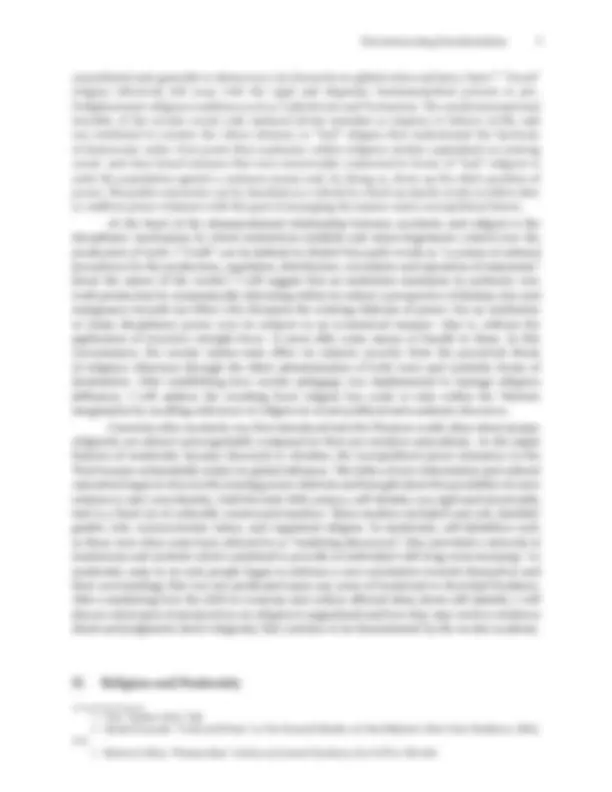
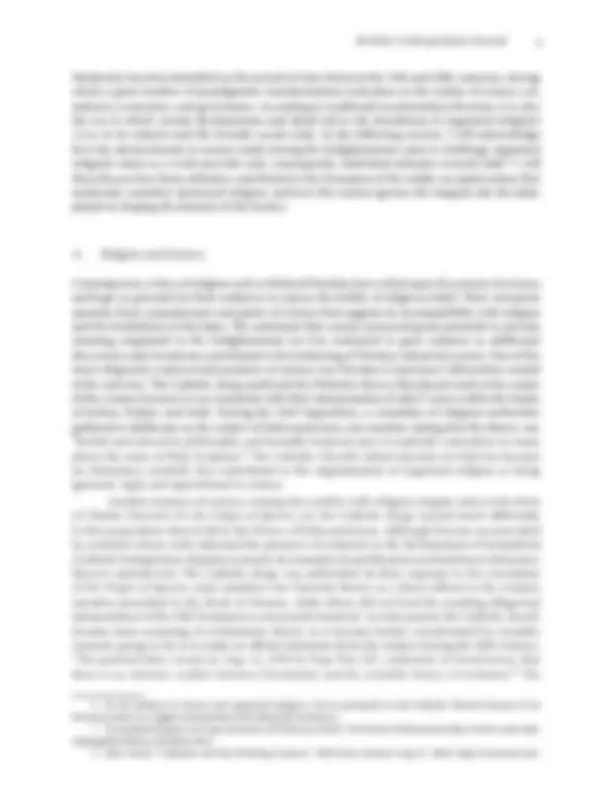
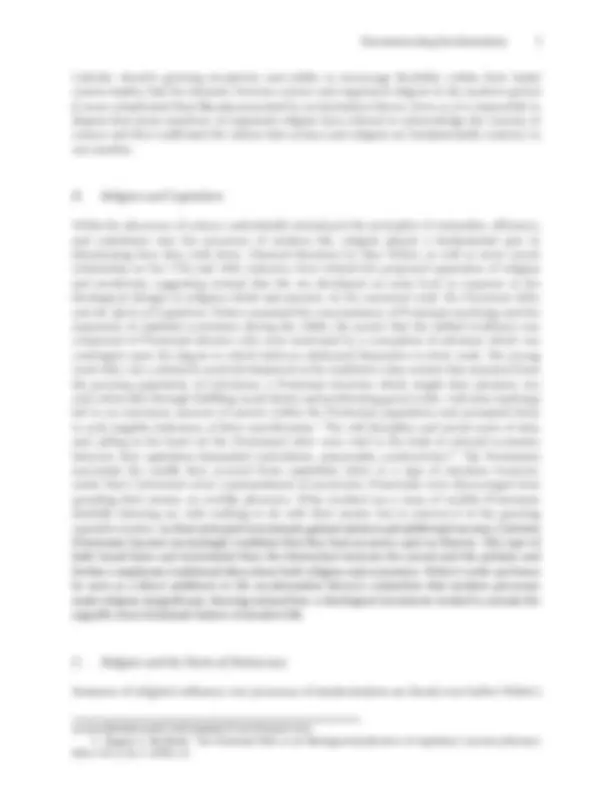
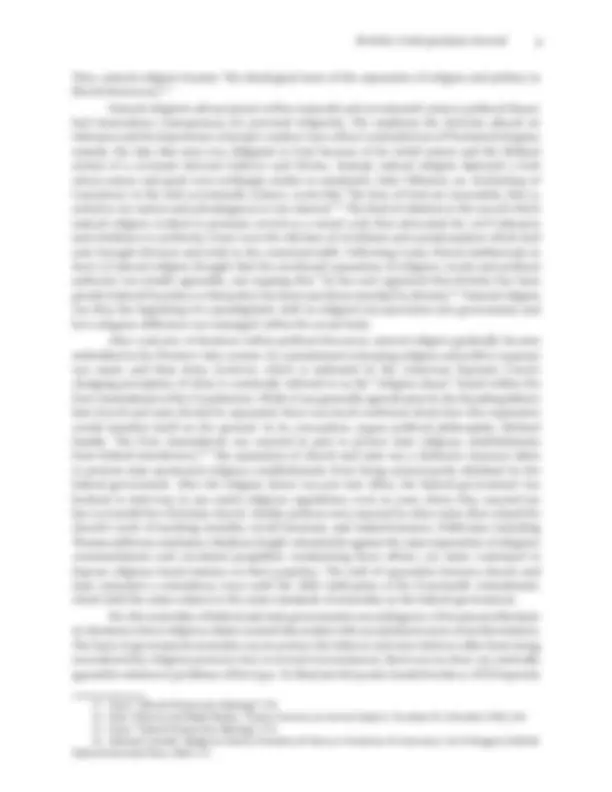
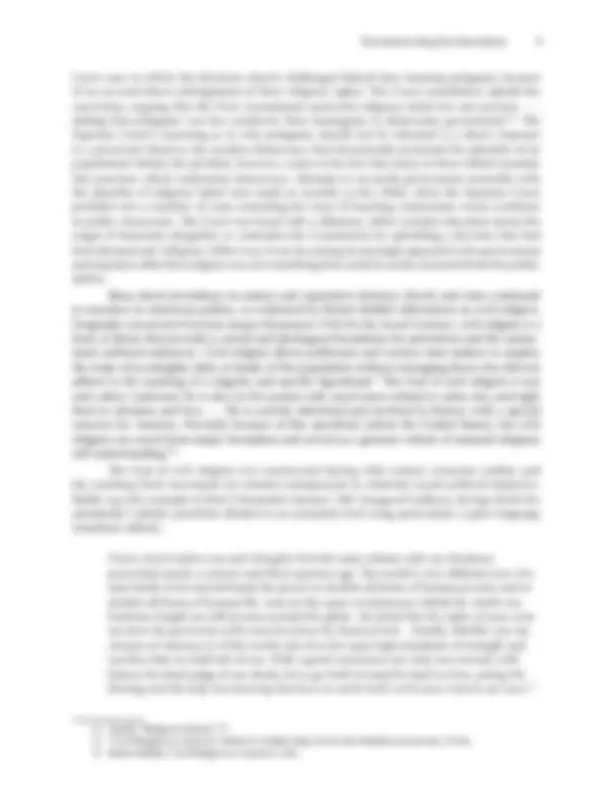
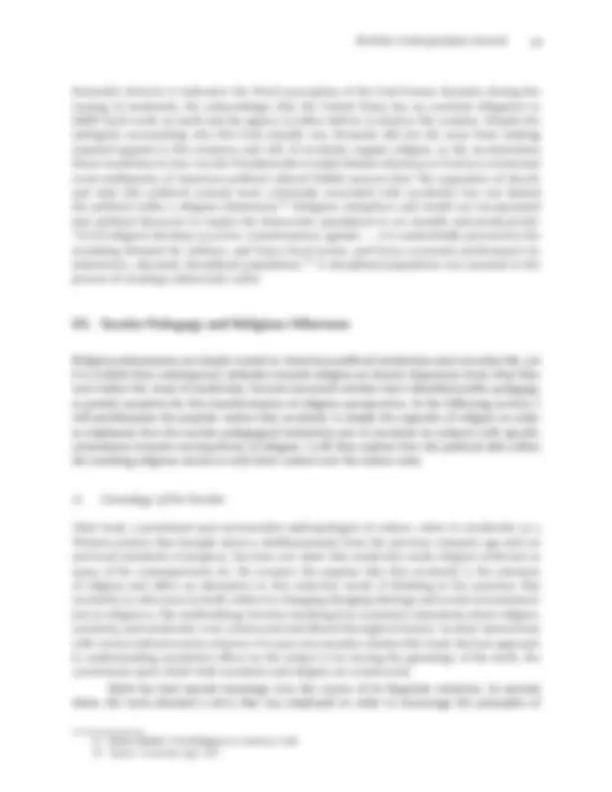
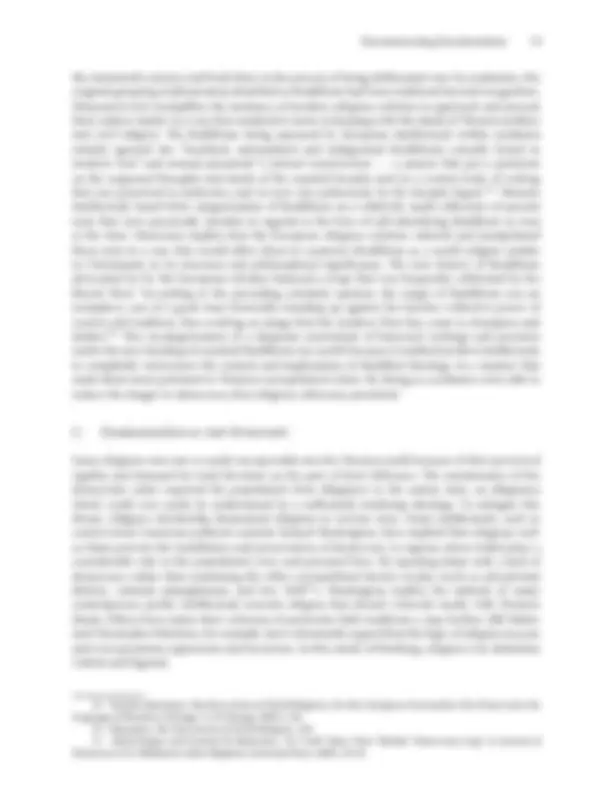
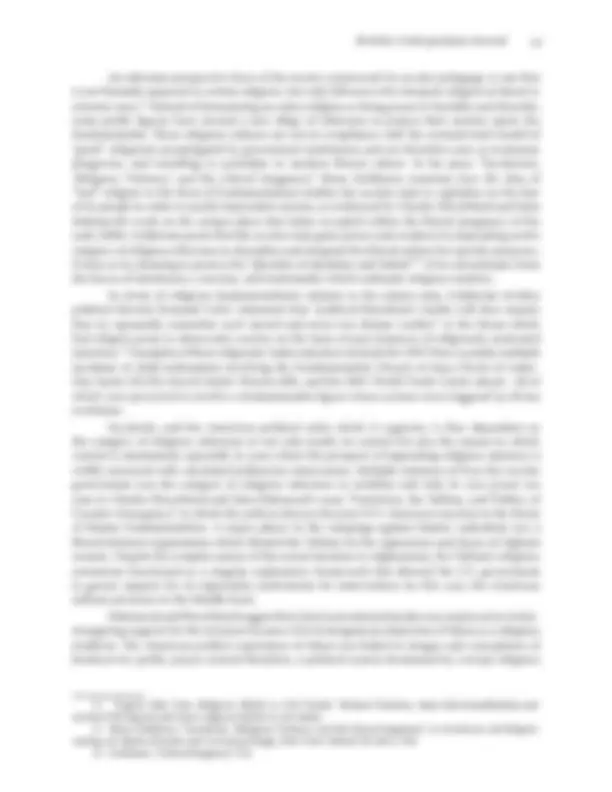
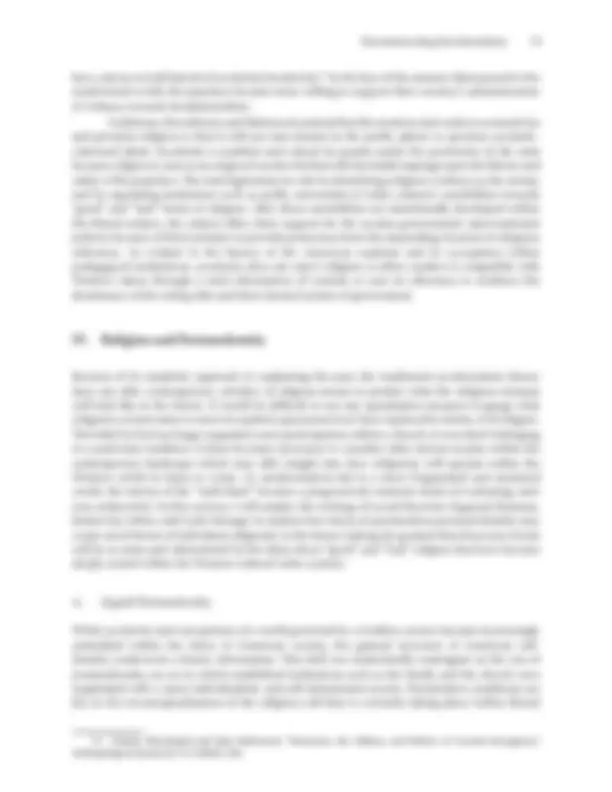
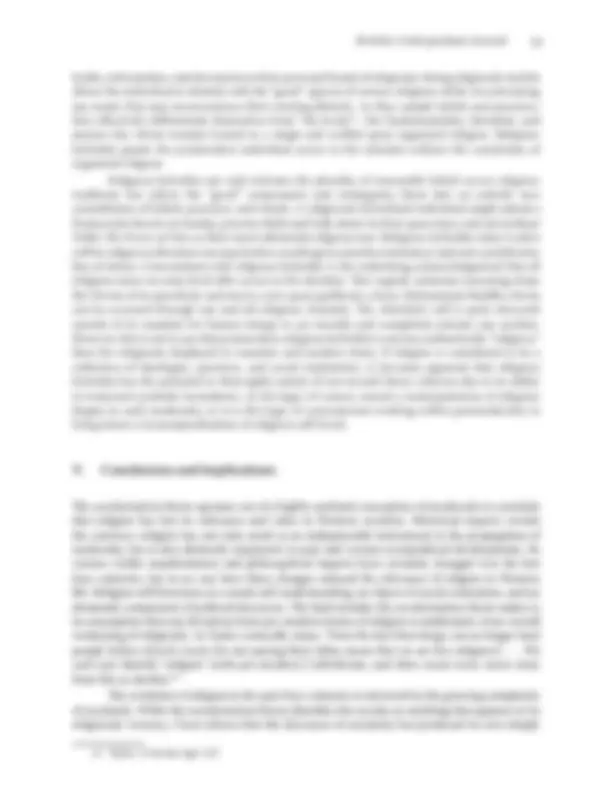
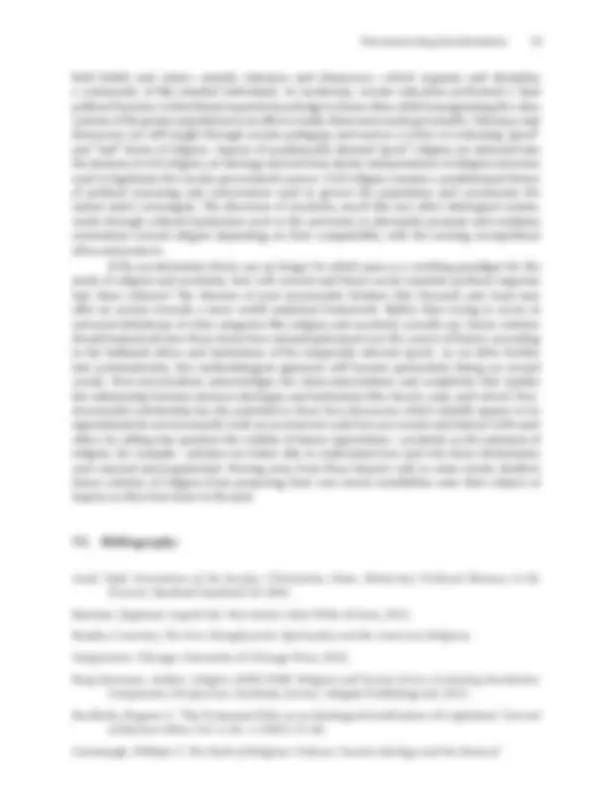
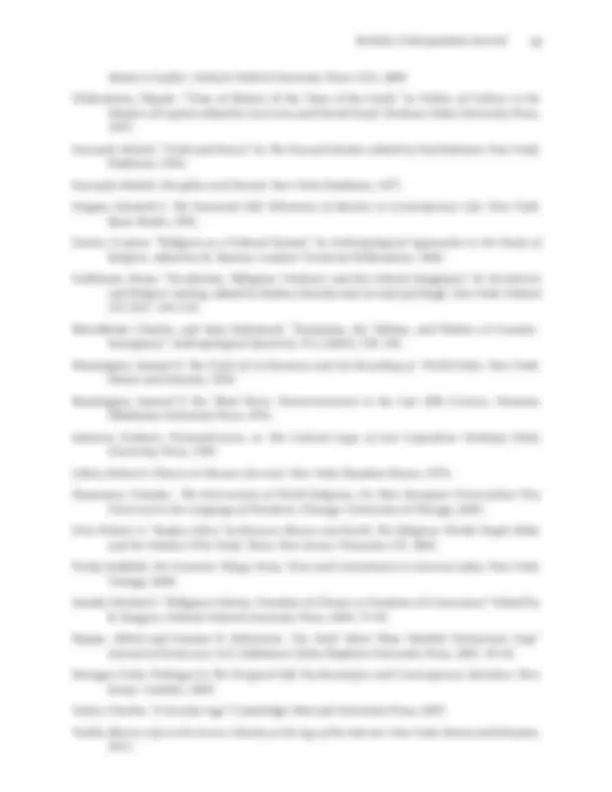
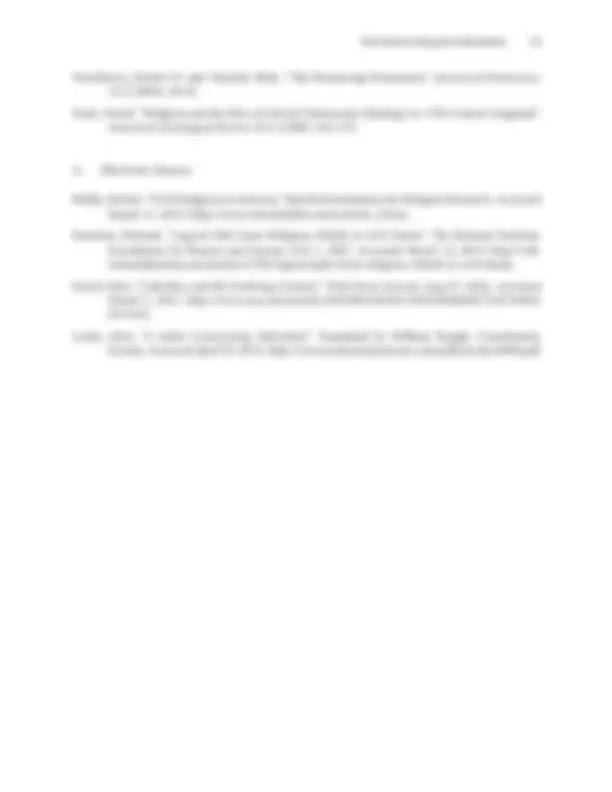


Study with the several resources on Docsity

Earn points by helping other students or get them with a premium plan


Prepare for your exams
Study with the several resources on Docsity

Earn points to download
Earn points by helping other students or get them with a premium plan
Community
Ask the community for help and clear up your study doubts
Discover the best universities in your country according to Docsity users
Free resources
Download our free guides on studying techniques, anxiety management strategies, and thesis advice from Docsity tutors
The relationship between religion and modernity, challenging the simplistic secularization thesis. The author examines how religion has interacted with institutions of power from the beginning of modernity to the present, highlighting the importance of understanding the historical context to predict religion's future. the role of 'good' religion in shaping secular pedagogy and its impact on the Western imagination, as well as the relationship between religion and science, capitalism, and liberal democracy.
What you will learn
Typology: Exercises
1 / 21

This page cannot be seen from the preview
Don't miss anything!














he secularization thesis is a prominent paradigm within the sociology of religion. It holds that modernity has made religion increasingly obsolete. This paper refutes the seculariza- tion thesis, arguing that religion was essential to modernity (particularly in its pertinence to the development of capitalism and democracy). Yet if religion is embedded within modern civic and political life, then what do we mean when we speak of “the secular”? I argue that secularity is a set of orientations and sensibilities towards religion that have evolved through their own repeated iteration within academia on religion. The discourse of the secular is crucial to the modern political project of governance; it creates and reifies power relations not only between the populace and the elite, but also between the west and the less modernized regions of the Middle East. However, the discourses of religion and secularity are entirely subject to changing cultural conditions. I posit that postmodernity—an era characterized by rampant consumerism and mobility—has engendered a new form of religiosity in which the individual is able to combine tenets and traditions from a mul- titude of traditions without experiencing cultural or cognitive dissonance in so doing. Because of religion’s reflexivity to societal change and the consistent impact it has made on the fruition of such development, the secularization thesis must be replaced by a more robust paradigm built upon the interconnectedness of the postmodern world and the longstanding interaction between religion, secularity and structures of power.
Deconstructing Secularization 1
The secularization thesis holds that as modernity progressed, religion came to occupy a decreasingly prominent place in the public and private spheres of Western life. As one considers the longstanding interdependence between the hallmark processes of modernity and forms of religion, it becomes evident that the secularization thesis is far too reductive in its analysis of history to adequately predict religion’s future (or lack of it). In order to draw conclusions regarding whether religion could ever feasibly be eradicated from Western life, it is necessary to analyze its historical interaction with institutions of power from modernity’s beginning to the present in a way that the secularization thesis fails to do. By analyzing the interplay between religion and three of the most obvious features of modernity—science, capitalism, and democracy—I will call into question some of the archaic conceptions of religion and secularity that underpin classic secularization theory. I will then consider how the forces of postmodernity may shape religion in the years to come, and how the West’s collective religious future will be inevitably influenced by the norms constructed through the modern secular academy. The secularization thesis implies that secularity itself is some vague form of un-religion that compensated for religion’s supposed absence as modernity went on. I will argue instead that the discourse of secularity is one of modernity’s “series of interlinked projects”^1 because it performs a rationalized and calculated function: it determines sensibilities towards religion in a manner that is advantageous to the Western nation-state’s politics. Secularity operates within culturally authoritative structures to inculcate the population with ideals meant to regulate their behavior and belief systems. In my discussion of the relation between secularity and religion, I will focus on the public university because of its status as a culturally authoritative structure which both produces and sanctions what counts for generally accepted knowledge. A sufficient examination of how secular forces mediate religiosity must pose the following questions: How does the secular state validate its authority through the medium of public pedagogy? Whom does it privilege or alienate in doing so? What sociopolitical goals does this process of discipline serve? What broader cultural values rooted in the narrative of modernity facilitate this relationship? The largely concealed nexus between secularity and religion becomes most conspicuous when considering how versions of religious and ethical values were imposed on students through course material in the public university. As the American nation-state began to take form, a secular pedagogy was necessary to attract the masses and transform them into docile citizens in favor of the government’s intended mode of politics: “The rationale for building colleges in the early Republic was explicitly understood as civilizing the population, taming it and creating out if its diversity a common culture of shared values and behaviors.”^2 After the Enlightenment, the emerging public university sought to efficiently instill democratic principles within its subjects by eliminating the multiplicities of belief and practice inherent in a large population. This initiative was especially problematized by religion, which was becoming increasingly perceived to be at odds with the rationality and logic in which the modern democratic order depended upon for its justification. Robert A. Orsi, scholar of religion and American history, holds that “good” religion is a certain brand of religiosity which took shape in the American university during the nineteenth century in response to felt contradictions between religion and logic. “Good” and “bad” forms of religion were communicated to students through the teaching of various scholarly works: “[Good] religion, then, is epistemologically and singular, rational, respectful of others, noncoercive… 1 Talal Asad, Formations of the Secular: Christianity, Islam, Modernity (Cultural Memory in the Present) (Stanford: Stanford UP, 2003), 13. 2 Robert Orsi, “Snakes Alive,” in Between Heaven and Earth: The Religious Worlds People Make and the Scholars Who Study Them (Princeton, NJ: Princeton UP, 2005), 184. Berkeley Undergraduate Journal 2
Modernity has been identified as the period of time between the 14th and 20th centuries, during which a great number of paradigmatic transformations took place in the realms of science, art, industry, economics, and governance. According to traditional secularization theorists, it is also the era in which certain developments and ideals led to the dissolution of organized religion’s claim to its subjects and the broader social order. In the following section, I will acknowledge how the advancements in science made during the Enlightenment came to challenge organized religion’s status as a truth provider and, consequently, individual attitudes towards faith.^6 I will then discuss how these attitudes contributed to the formation of the widely accepted notion that modernity somehow destroyed religion, and how this notion ignores the integral role the latter played in shaping the features of the former.
Contemporary critics of religion such as Richard Dawkins have relied upon the axioms of science and logic as grounds for their endeavor to expose the futility of religious belief. Their viewpoint operates from a popularized conception of science that suggests its incompatibility with religion and the foolishness of the latter. The sentiment that science possessed great potential to provide meaning originated in the Enlightenment era but continued to gain credence as additional discoveries and inventions contributed to the bolstering of Western industrial society. One of the most religiously controversial products of science was Nicolaus Copernicus’ heliocentric model of the universe. The Catholic clergy preferred the Ptolemic theory that placed earth at the center of the cosmos because it was consistent with their interpretation of select verses within the books of Joshua, Psalms, and Isiah. During the 1616 Inquisition, a committee of religious authorities gathered to deliberate on the subject of heliocentricism, one member stating that the theory was “foolish and absurd in philosophy, and formally heretical since it explicitly contradicts in many places the sense of Holy Scripture.”^7 The Catholic Church’s initial rejection of what has become an elementary scientific fact contributed to the stigmatization of organized religion as being ignorant, rigid, and oppositional to science. Another instance of science coming into conflict with religious dogma came in the form of Charles Darwin’s On the Origin of Species; yet, the Catholic clergy reacted much differently to this proposition than it did to the theory of heliocentricism. Although Darwin was preceded by scientists whose work indicated the presence of evolution in the development of humankind (Catholic biologist Jean-Baptiste Lamarck, for example), his publication was lauded as evolutionary theory’s seminal text. The Catholic clergy was ambivalent in their response to the circulation of the Origin of Species; some members saw Darwin’s theory as a direct affront to the creation narrative presented in the Book of Genesis, while others did not find the resulting allegorical interpretation of the Old Testament as necessarily heretical. As time passed, the Catholic church became more accepting of evolutionary theory as it became further corroborated by scientific research, going so far as to make an official statement about the subject during the 20th century: “The pastoral letter, issued on Aug. 12, 1950 by Pope Pius XII, confirmed, in broad terms, that there is no intrinsic conflict between Christianity and the scientific theory of evolution.”^8 The 6 In my analysis of science and organized religion, I focus primarily on the Catholic Church because of its historical status as a highly systematized and influential institution. 7 “Consultant’s Report on Copernicanism (24 February 1616),” University of Minnesota, http://www1.umn.edu/ ships/galileo/library/1616docs.htm. 8 John Farrel, “Catholics and the Evolving Cosmos,” Wall Street Journal, Aug 27, 2010, http://www.wsj.com/ Berkeley Undergraduate Journal 4
Catholic church’s growing receptivity and ability to encourage flexibility within their belief system implies that the dynamic between science and organized religion in the modern period is more complicated than the one presented by secularization theory. Even so, it is impossible to dispute that many members of organized religion have refused to acknowledge the veracity of science and thus reaffirmed the notion that science and religion are fundamentally contrary to one another.
While the discourse of science undoubtedly introduced the principles of rationality, efficiency, and orderliness into the processes of modern life, religion played a fundamental part in determining how they took form. Classical literature by Max Weber, as well as more recent scholarship on the 17th and 18th centuries, have refuted the proposed separation of religion and modernity, suggesting instead that the era developed on some level in response to the theological changes in religious belief and practice. In his canonical work The Protestant Ethic and the Spirit of Capitalism, Weber examined the concomitance of Protestant teachings and the expansion of capitalist economics during the 1800s. He asserts that the skilled workforce was comprised of Protestant laborers who were motivated by a conception of salvation which was contingent upon the degree to which believers dedicated themselves to their work. The strong work ethic was a relatively novel development in the tradition’s value system that stemmed from the growing popularity of Calvinism, a Protestant doctrine which taught that salvation was only achievable through fulfilling social duties and performing good works. Calvinist teachings led to an enormous amount of anxiety within the Protestant population and prompted them to seek tangible indicators of their sanctification: “The self-discipline and moral sense of duty and calling at the heart [of the Protestant] ethic were vital to the kind of rational economic behavior that capitalism demanded (calculation, punctuality, productivity).”^9 The Protestants associated the wealth they accrued from capitalistic labor as a sign of salvation; however, under their Calvinism’s strict commandment of asceticism, Protestants were discouraged from spending their money on worldly pleasures. What resulted was a mass of wealthy Protestants dutifully laboring on, with nothing to do with their money but to reinvest it in the growing capitalist market. As their principal investments gained interest and additional income, Calvinist Protestants became increasingly confident that they had secured a spot in Heaven. This type of faith-based labor and investment blurs the distinction between the sacred and the profane and further complicates traditional ideas about both religion and economics. Weber’s work can hence be seen as a direct antithesis to the secularization theory’s contention that modern processes made religion insignificant, showing instead how a theological movement worked to actuate the arguably most dominant feature of modern life.
Instances of religion’s influence over processes of modernization are found even before Weber’s articles/SB10001424052748703846604575447493644515142. 9 Rogene A. Buchholz, “The Protestant Ethic as an Ideological Justification of Capitalism,” Journal of Business Ethics Vol. 2, No. 1 (1983), 51. Deconstructing Secularization 5
about tolerance and reason within the church were also extended to matters of government, eventuating in a call for a mutually beneficial separation of religion and politics. In his 1689 “A Letter Concerning Toleration,” Locke wrote: The toleration of those that differ from others in matters of religion is so agreeable to the Gospel of Jesus Christ, and to the genuine reason of mankind, that it seems monstrous for men to be so blind as not to perceive the necessity and advantage of it in so clear a light… I esteem it above all things necessary to distinguish exactly the business of civil government from that of religion and to settle the just bounds that lie between the one and the other. If this be not done, there can be no end put to the controversies that will be always arising between those that have, or at least pretend to have, on the one side, a concernment for the interest of men’s souls, and, on the other side, a care of the commonwealth.^14 Locke and his contemporaries reshaped religious philosophy by encouraging believers to remedy the civil unrest by accepting those whose beliefs differed from their own and keeping faith partitioned from politics. Their work advocated for the embrace of rationalism, reiterating that it could be used to both prove the existence of their Creator and assuage sectarian unrest (albeit only through a policy of religious tolerance). The widespread intellectual sentiment in reason’s capacity to reveal and reaffirm religious truth was an externality of science’s growing presence within Western society: “because of the success of the new science, there was an insistence on a simpler, doctrinally less elaborated religion, and one more accessible to reason.”^15 The ethos of science and rationalism permeated religious discourse as Locke and his colleagues used the precepts of reason in determining God’s will for the social and political orders.
The linking of science and religion by reason signifies the transition from what Zaret refers to as providence-in-society to providence-in-nature. This axiomatic transformation was bolstered by the aforementioned work of John Locke and the chaos of the English Revolution: many were unable to reconcile the idea that a divine entity plays an active role in determining the political order in a time period that exemplified immense social disarray. Christians conceded the notion that God played an active role in determining and maintaining social organization and insisted instead that his providence was found exclusively in nature: “Order and harmony in nature were evidence of God’s existence; and in nature God’s glory was not troubled by the religious conflicts that had disturbed the social order.”^16 Providence-in-nature was a facet of a larger concept: natural religion. Natural religion was a new way of deciphering not only God’s presence in the physical world, but also his accessibility through the intermediates of reason and rationality. Because the political upheaval taking place called into question the legitimacy of providence-in-nature, no particular sect or religious ideology was able to distinguish itself as the sole authority on how to correctly actualize a godly politics. Natural religion blocked any single religious group’s ability to claim oligarchical power since they could no longer call upon divine mandate for exoneration. 14 John Locke, “A Letter Concerning Toleration,” trans. by William Popple, http://www.constitution.org/jl/ tolerati.htm. 15 Charles Taylor, “A Secular Age” (Cambridge: Harvard University Press, 2007), 224. 16 Zaret, “LIberal-Democratic Ideology,” 174. Deconstructing Secularization 7
Thus, natural religion became “the ideological basis of the separation of religion and politics in liberal democracy.”^17 Natural religion’s advancement within sixteenth and seventeenth century political theory had tremendous consequences for personal religiosity. The emphasis the doctrine placed on tolerance and the importance of proper conduct was a direct contradiction of Puritanical dogma: namely, the idea that man was obligated to God because of his sinful nature and the Biblical notion of a covenant between believer and Divine. Instead, natural religion depicted a God whose nature and goals were strikingly similar to mankind’s. John Tillotson, an Archbishop of Canterbury in the mid-seventeenth century, wrote that “the laws of God are reasonable, that is, suited to our nature and advantageous to our interest.”^18 The kind of relation to the sacred which natural religion worked to promote served as a moral code that advocated for civil tolerance and obedience to authority. Gone were the old days of revelation and sensationalism which had only brought division and strife to the commonwealth. Following Locke, liberal intellectuals in favor of natural religion thought that the newfound separation of religious creeds and political authority was jointly agreeable, one arguing that “[it has not] appeared that divinity has been greatly bettered by policy or that policy has been anywhere mended by divinity.”^19 Natural religion was thus the beginning of a paradigmatic shift in religion’s incorporation into government and how religious difference was managed within the social body. After centuries of iteration within political discourse, natural religion gradually became embedded in the Western value system. Its commitment to keeping religion and politics separate was easier said than done, however, which is indicated by the American Supreme Court’s changing perception of what is commonly referred to as the “religion clause” found within the First Amendment of the Constitution. While it was generally agreed upon by the founding fathers that church and state should be separated, there was much confusion about how this separation would manifest itself on the ground. In its conception, argues political philosopher Michael Sandel, “the First Amendment was enacted in part to protect state religious establishments from federal interference.”^20 The separation of church and state was a defensive measure taken to prevent state-sponsored religious establishments from being unnecessarily inhibited by the federal government. After the religion clause was put into effect, the federal government was hesitant to intervene in any state’s religious regulations, even in cases where they enacted tax laws to benefit the Christian church. Similar policies were enacted by other states that valued the church’s work of teaching morality, social harmony, and industriousness. Politicians including Thomas Jefferson and James Madison fought vehemently against the state imposition of religious commandments and circulated pamphlets condemning these efforts, yet states continued to impose religious-based statutes on their populace. The wall of separation between church and state remained a contentious issue until the 1868 ratification of the Fourteenth Amendment, which held the states subject to the same standards of neutrality as the federal government. Yet, this neutrality of federal and state governments was ambiguous. It became problematic in situations where religious claims seemed discordant with accepted processes of modernization. The basis of government neutrality was to protect the believer and non-believer alike from being encumbered by religious pressure, but, in several circumstances, there was no clear-cut, mutually agreeable solution to problems of this type. To illustrate this point, Sandel invokes a 1878 Supreme 17 Zaret, “LIberal-Democratic Ideology,” 174. 18 John Tillotson and Ralph Barker, “Sixteen Sermons on Several Subjects,” (London: R. Chiswell, 1700), 292. 19 Zaret, “Liberal-Democratic Ideology,” 175. 20 Michael J. Sandel, “Religious Liberty: Freedom of Choice or Freedom of Conscience,” ed. R. Bargava (Oxford: Oxford University Press, 2005), 75. Berkeley Undergraduate Journal 8
Kennedy’s rhetoric is indicative the West’s perception of the God-human dynamic during the waning of modernity. He acknowledges that the United States has an essential obligation to fulfill God’s work on earth and the agency to either deliver or destroy His creation. Despite the ambiguity surrounding who this God actually was, Kennedy did not shy away from making repeated appeals to His existence and will. If secularity negates religion, as the secularization thesis would have it, how was the President able to make blatant references to God in a ceremonial event emblematic of American political culture? Bellah answers that “the separation of church and state [the political concept most commonly associated with secularity] has not denied the political realm a religious dimension.”^24 Religious metaphors and motifs are incorporated into political discourse to inspire the democratic population to act morally and productively: “[Civil religion] develops an active, transformatory agenda... it is undoubtedly powered by the escalating demand for military, and hence fiscal power, and hence economic performance by industrious, educated, disciplined populations.”^25 A disciplined population was essential to the process of creating a democratic order.
Religious phenomena are deeply rooted in American political institutions and everyday life, yet it is evident that contemporary attitudes towards religion are drastic departures from what they were before the onset of modernity. Several renowned scholars have identified public pedagogy as partial causation for this transformation of religious perspectives. In the following section, I will problematize the popular notion that secularity is simply the opposite of religion in order to emphasize how the secular pedagogical institution acts to inculcate its subjects with specific orientations towards varying forms of religion. I will then explore how the political elite utilize the resulting religious norms to reify their control over the nation-state.
Talal Asad, a prominent post-structuralist anthropologist of culture, refers to modernity as a Western project that brought about a disillusionment from the previous romantic age and set universal standards of progress, but does not claim that modernity made religion irrelevant as many of his contemporaries do. He counters the popular idea that secularity is the antonym of religion and offers an alternative to this reductive mode of thinking in his assertion that secularity is a discourse in itself, subject to changing changing ideology and social circumstances just as religion is. His methodology involves studying how normative statements about religion, secularity, and modernity were constructed and altered throughout history via their interactions with various infrastructures of power. For post-structuralist scholars like Asad, the best approach to understanding secularity’s effect on the subject is by tracing the genealogy of the myth, the cornerstone upon which both secularity and religion are constructed. Myth has had myriad meanings over the course of its linguistic existence. In ancient times, the term denoted a story that was employed in order to encourage the principles of 24 Robert Bellah, “Civil Religion in America,” web. 25 Taylor, “A Secular Age,” 107. Berkeley Undergraduate Journal 10
bravery, honor, and unity within the populace. It was not until after the Enlightenment that the term became analogous to fable or a distortion of reality and was used as a medium for the exploration of possible actions and their repercussions. A prime example of the use of myth as an obviously fictive but nonetheless useful explorative exercise was Freud’s incorporation of the Oedipus myth into his psychoanalytic theory. For Freud, myth served as a means of investigating the repressed undercurrents of human thought. Although it was still used in culture for creative or aesthetic purposes, myth came to be perceived as irrational compared to the irrefutable nature of scientific explanation that became standardized during the Enlightenment period. Secular discourse aimed to differentiate itself from religion by constructing itself as being non-mythic, therefore rational. Asad criticizes other scholars’ of religion attempts to expose secularity’s true basis in myth and thus it’s necessarily religious nature; he concludes that secularity is not a form of religion although the two discourses may possibly have common mythical roots. After detailing the etymology of the myth, Asad asserts that the grammar of secularity justifies its own production of knowledge and power through its ties to the modern nation-state. It is not a new form of religion created for humanists and atheists as some have suggested—it is a widely known collection of narratives and values that allow deistic civil religion to flourish. Asad states that secularity is comprised of two supporting myths which combine to reinforce power relations between the laymen and elite. The first myth inherent to secular discourse is that rational knowledge can abolish human suffering if it is ordained by an enlightened elite. By this utilitarian logic, the enlightened elite is justified in maintaining their elevated position for the betterment of wider society. The second myth becomes somewhat problematic when juxtaposed with the first and is undoubtedly linked to the work of providence-in-nature political theorists of the 17th century: each individual should be empowered to determine their own destiny according to their personal sensibilities, but still have less agency than the intellectual elite. The actualization of these secular myths is easily observable in Western cultures. Secular education, the primary channel through which knowledge is passed down, acts on the subject to induct them into the enlightened class. Those who do not directly benefit from the knowledge granted by the intellectual elite via secular pedagogy are situated near the bottom of the social hierarchy. The uneducated population’s general lack of formal knowledge begets the existence of an elite tier of society to function as logical decision makers in their stead. In this manner, pedagogy and its consequential power relations further solidify the arrangement of social order through the creation and instruction of new forms of knowledge. Secular pedagogy was a fundamental player in the emergence of the modern nation-state because it facilitated democratic attitudes. “Direct-access character” and “grounding in secular, homogeneous time”^26 fostered a sense of national unity because all members of the nation-state were situated within a common secular experiential frame of reference. The secular educational system and various sectors of commercial and governmental media are tasked with mediating images and ideologies to be projected onto the subject in order for them to appropriate the necessary democratic mindset. Asad implies that the end goal of secularization has less to do with eradicating religion (this would impose a negative definition on secularity and define the category by what it is not) than it does with cultivating certain attitudes and dispositions towards religiosity that would not otherwise be so ubiquitous. Secular discourse situates its subject in an imagined sociopolitical landscape that enables them to play an active role in redemptive politics characterized by the ideals of moral responsibility and individual sanctity. Redemptive politics are central to the 26 Talal Asad, Formations of the Secular: Christianity, Islam, Modernity (Cultural Memory in the Present) (Stanford: Stanford UP, 2003), 2. Deconstructing Secularization 11
the nineteenth century and finds that, in the process of being deliberated over by academics, the original grouping of phenomena identified as Buddhism had been redefined beyond recognition. Masuzawa’s text exemplifies the tendency of modern religious scholars to approach and present their subject matter in a way that rendered it more in keeping with the ideals of Western politics and civil religion. The Buddhism being espoused by European intellectuals within academia entirely ignored the “localized, nationalized and indigenized Buddhisms actually found in modern Asia” and instead presented “a textual construction... a project that put a premium on the supposed thoughts and deeds of the reputed founder and on a certain body of writing that was perceived to authorize, and in turn was authorized, by the founder figure.”^29 Western intellectuals based their categorization of Buddhism on a relatively small collection of ancient texts that were practically obsolete in regards to the lives of self-identifying Buddhists in Asia at the time. Masuzawa implies that the European religious scholars selected and manipulated these texts in a way that would allow them to construct Buddhism as a world religion similar to Christianity in its structure and philosophical significance. The new history of Buddhism advocated for by the European scholars featured a trope that was frequently celebrated by the liberal West: “According to the prevailing scholarly opinion, the origin of Buddhism was an exemplary case of a great man heroically standing up against the faceless collective power of society and tradition, thus evoking an image that the modern West has come to champion and idolize.”^30 This recategorization of a disparate assortment of historical writings and practices under the new heading of essential Buddhism was useful because it enabled modern intellectuals to completely restructure the content and implications of Buddhist theology in a manner that made them more pertinent to Western sociopolitical values. By doing so, academics were able to reduce the danger to democracy that religious otherness presented.
Some religions were not so easily incorporable into the Western mold because of their perceived rigidity and demand for total devotion on the part of their followers. The maintenance of the democratic order required the population’s firm allegiance to the nation state, an allegiance which could very easily be undermined by a sufficiently totalizing ideology. To mitigate this threat, religious scholarship demonized religions in various ways. Some intellectuals, such as controversial American political scientist Samuel Huntington, have implied that religions such as Islam prevent the installation and preservation of democracy in regions where belief plays a considerable role in the population’s civic and personal lives. By equating Islam with a lack of democracy rather than examining the other sociopolitical factors at play (such as educational deficits, colonial entanglement, and low GDP^31 ), Huntington typifies the attitude of many contemporary public intellectuals towards religion that doesn’t coincide neatly with Western ideals. Others have taken their criticism of particular faith traditions a step further. Bill Maher and Christopher Hitchens, for example, have vehemently argued that the logic of religion excuses and even promotes oppression and terrorism. In this mode of thinking, religion is by definition violent and bigoted. 29 Tomoko Masuzawa, The Intervention of World Religions, Or, How European Universalism Was Preserved in the Language of Pluralism (Chicago: U of Chicago, 2005), 136. 30 Masuzawa, The Intervention of World Religions, 136. 31 Alfred Stepan and Graeme B. Robertson, “An ‘Arab’ More Than ‘Muslim’ Democracy Gap,” in Journal of Democracy 14:3 (Baltimore: Johns Hopkins University Press, 2003), 39-42. Deconstructing Secularization 13
An alternate perspective born of the norms constructed by secular pedagogy is one that is not blatantly opposed to certain religions, but only followers who interpret religion in literal or extreme ways.^32 Instead of demonizing an entire religion as being prone to brutality and disorder, some public figures have erected a new effigy of otherness to project their anxiety upon: the fundamentalist. These religious subjects are not in compliance with the normativized model of “good” religiosity promulgated by government institutions and are therefore seen as irrational, dangerous, and unwilling to assimilate to modern liberal culture. In his piece “Secularism, ‘Religious Violence,’ and the Liberal Imaginary,” Brian Goldstone examines how the idea of “bad” religion in the form of fundamentalism enables the secular state to capitalize on the fear of its people in order to justify imperialist actions, as evidenced by Charles Hirschkind and Saba Mahmood’s work on the unique place that Islam occupied within the liberal imaginary of the early 2000s. Goldstone posits that the secular state gains power and credence by depending on the category of religious otherness to discipline and integrate the liberal subject for specific purposes. It does so by claiming to protect the “plurality of identities and beliefs”^33 of its subordinates from the forces of intolerance, coercion, and irrationality which underpin religious zealotry. In terms of religious fundamentalism’s relation to the nation-state, Goldstone invokes political theorist Romand Coles’ statement that “political liberalism’s vitality will thus require that we repeatedly remember such mortal and never-too-distant conflict” or the threat which bad religion poses to democratic society on the basis of past instances of religiously-motivated injustices.^34 Examples of these religiosity-laden injustices include the 1993 Waco scandal, multiple incidents of child molestation involving the Fundamentalist Church of Jesus Christ of Latter- Day Saints (FLDS) church leader Warren Jeffs, and the 2001 World Trade Center attack—all of which were perceived to involve a fundamentalist figure whose actions were triggered by divine revelation. Secularity, and the American political order which it supports, is thus dependent on the category of religious otherness to not only justify its control but also the means by which control is maintained, especially in cases where the prospect of impending religious injustice is swiftly answered with calculated militaristic intercession. Multiple instances of how the secular government uses the category of religious otherness to mobilize and reify its own power are seen in Charles Hirschkind and Saba Mahmood’s essay “Feminism, the Taliban, and Politics of Counter-Insurgency,” in which the authors discuss the post-9/11 American reaction to the threat of Islamic fundamentalism. A major player in the campaign against Islamic radicalism was a liberal feminist organization which blamed the Taliban for the oppression and abuse of Afghani women. Despite the complex nature of the actual situation in Afghanistan, the Taliban’s religious extremism functioned as a singular explanatory framework that allowed the U.S. government to garner support for its imperialist motivations for intervention (in this case, the American military presence in the Middle East). Mahmood and Hirschkind suggest that American national media was a major actor in fear- mongering support for the invasion because of its homogeneous depiction of Islam as a religious tradition. The American public’s experience of Islam was linked to images and conceptions of headscarves, public prayer, textual literalism, a political system dominated by corrupt religious 32 “Logical Path from Religious Beliefs to Evil Deeds,” Richard Dawkins, http://old.richarddawkins.net/ articles/1700-logical-path-from-religious-beliefs-to-evil-deeds. 33 Brian Goldstone, “Secularism, ‘Religious Violence,’ and the Liberal Imaginary,” in Secularism and Religion- making, ed. Markus Dressler and Arvind-pal Singh, (New York: Oxford UP, 2011), 106. 34 Goldstone, “Liberal Imaginary,” 113. Berkeley Undergraduate Journal 14
America. As the institutions and ways of life that characterized modernity were eroded, a new relation towards self-identity emerged as a means of coping with the rapid pace of social change. The new sense of self is a departure from the more fixed, defined self common in Western modernity: it is able to consolidate seemingly conflicting tastes, sensibilities, and orientations to the world without experiencing much in the way of cognitive dissonance from doing so. The term “postmodernity” has come to stand for both the events that signified a disjuncture from modern ways of life and, more generally, the markedly accelerated rate of societal change propagated in the late twentieth century. Multinational capitalism and the outsourcing of labor replaced the industrial city center and demolished the unionized workforce. The economic dealings of these multinational corporations were obscured and intertwined in the abstract globalized market, allowing the distribution of wealth and resources to further polarize among socioeconomic classes. Strong political leaders who formerly unified their constituents through their charisma and moxie lost their credibility due to publicized scandals or the loudness of competing voices.^36 The increased access to digitized information systems enabled by the ubiquity of the computer and internet exposed populations to new perspectives and ideological systems from which they had been previously sequestered. With this newfound access to an abundance of knowledge came both enlightenment and disillusionment: people became more cognizant of the infinite options and possibilities their world presented but alienated from the traditional institutions that once anchored them. The almost infinite supply of readily available (and often controversial) information in the hyper-connected global network made continuous social and personal change the norm. The emphasis on change found within postmodernity generated a recalibration of personal identity in order to keep up with the dynamic climate of what Bauman calls “liquid life”. The individual lives in conditions of constant uncertainty and has tremendous difficulty locating itself in relation to the ever-shifting surroundings. Bauman describes this state of life as characterized by an “acceptance of disorientation, immunity to vertigo and adaptation to a state of dizziness... looseness of attachment and revocability of engagement are the precepts guiding everything [the liquid individual engages] and to which they are attached.”^37 For the liquid individual, the idea of long-term commitment—whether to an endeavor, traditional ideology, or interpersonal relationship—has become almost unthinkable due to the increased capacity for emotional and physical mobility. Bauman’s theorization of the liquid individual is echoed in Lifton’s work on the protean man, a hypothetical figure whose identity is as diffuse, polymorphous, and fluid as the era he lives in: One encounters in the protean man what I would call strong ideological hunger. He is starved for ideas and feelings that can give coherence to his world, but here too his taste is toward new combinations. While he is by no means without yearning for the absolute, what he finds most acceptable are images of a more fragmentary nature than those of the ideologies of the past; and these images, although limited and often fleeting, can have great influence upon his psychological life.^38 36 Kenneth J. Gergen, The Saturated Self: Dilemmas of Identity in Contemporary Life (New York: Basic Books, 1991), 203. 37 Zygmunt Bauman, Liquid Life (New Jersey: John Wiley & Sons, 2013), 4. 38 Robert J. Lifton, History & Human Survival (New York: Random House, 1970), 324. Berkeley Undergraduate Journal 16
Here we arrive at a dilemma. In the past, mankind’s longing for the absolute was satisfied by totalizing ideologies which provided meaning or context to the seemingly arbitrary and disordered nature of life. That is no longer the case, for postmodern conditions have made it all but impossible to remain grounded by the traditional symbols and institutions which stood for these totalizing ideologies. Lifton depicts the protean man as being spiritually homeless because of his lack of long-standing ideological commitments to mediate his identity and actions. Because of this, Lifton posits that the protean man has no superego and is thus symbolically fatherless. Strenger, a psychoanalyst, also situates this apprehension towards commitment as a symptom of living within a fatherless society. Strenger’s conception of fatherlessness is both literal (in that much of the current generation grew up in a household with an absentee parent for varying reasons) and metaphorical; Strenger follows fellow psychoanalyst Jacques Lacan in likening the “paternal role” to “the symbol for cultural authority itself... For people born into Western culture, this implies a huge tradition that reaches from Judeo-Christian sources... through the canon of Western literature, art, philosophy, and science.”^39 Strenger’s argument suggests that traditional Western canons, including extensions of organized religion which dictate how religious subjects should feel and act, have been made practically obsolete and are therefore ineffective modes for understanding one’s own self or its relation to the larger world. Strenger’s and Lifton’s respective work indicate that for the postmodern individual, the prospect that committing to any single ideology might offer access to a universal truth—an absolute—seems absurd and outdated.
What, then, is the relation between the postmodern individual and religion if the latter can no longer function as a totalizing ideology? Perhaps the best way of answering this question would be through considering how Bauman’s concept of hybridity can be applied to religious discourse to form the “new combinations” Lifton’s protean man seeks. Bauman argues that relatively affluent (that is, above the poverty line) Westerners partake in a culture of hybridization that can be likened to what some have called “no brow culture”, or one that indiscriminately appropriates various tastes regardless of their geographical or historical origins. Bauman’s description of the hybridized individual centers on the transcendence of spatial borders of territories and symbolic boundaries of cultures: Hybrid culture is manifestly omnivorous - non-commital, unchoosy, unpredjudiced, ready and eager to savour everything on offer and to ingest and digest food from all cuisines… [it] is an ideological gloss on achieved or claimed extraterritoriality. Exempted from the sovereignty of territorially circumscribed political units, just like the extraterritorial networks inhabited by the global elite, ‘hybrid culture’ seeks its identity in freedom from ascribed and inert identities, in a licence to defy and neglect the kinds of cultural markers, labels or stigmas that circumscribe and limit the movements and choices of the place-bound rest: the ‘locals’.^40 The construction of the hybridized individual entails a continuous process of selection from a global and infinite domain of values. In the context of religion, the hybridized individual alternately 39 Carlo Strenger, prologue to The Designed Self: Psychoanalysis and Contemporary Identities (New Jersey: Analytic, 2005), Xv. 40 Bauman, Liquid Life, 32. Deconstructing Secularization 17
held beliefs and values—namely tolerance and democracy—which organize and discipline a community of like-minded individuals. In modernity, secular education performed a dual political function: it distributed requisite knowledge to future elites while homogenizing the value systems of the greater population in an effort to make them more easily governable. Tolerance and democracy are still taught through secular pedagogy and used as a rubric in evaluating “good” and “bad” forms of religion. Aspects of academically-deemed “good” religion are inducted into the domain of civil religion, an ideology derived from deistic interpretations of religious doctrine used to legitimate the secular government’s power. Civil religion remains a predominant fixture of political reasoning and conversation used to govern the population and corroborate the nation-state’s sovereignty. The discourse of secularity, much like any other ideological system, works through cultural institutions such as the university to alternately promote and condemn orientations toward religion depending on their compatibility with the existing sociopolitical ethos and projects. If the secularization thesis can no longer be relied upon as a working paradigm for the study of religion and secularity, how will current and future social scientists perform inquiries into these subjects? The theories of post-structuralist thinkers like Foucault and Asad may offer an avenue towards a more useful analytical framework. Rather than trying to arrive at universal definitions of what categories like religion and secularity actually are, future scholars should instead ask how these terms have metamorphosized over the course of history according to the hallmark ethics and institutions of the temporally relevant epoch. As we delve further into postmodernity, this methodological approach will become particularly fitting on several counts. Post-structuralism acknowledges the interconnectedness and complexity that typifies the relationship between abstract ideologies and institutions like church, state, and school. Post- structuralist scholarship has the potential to show how discourses which initially appear to be oppositional do not necessarily work on an inversive scale but can coexist and interact with each other; by calling into question the validity of binary oppositions—secularity as the antonym of religion, for example—scholars are better able to understand how and why these dichotomies were enacted and popularized. Moving away from these binaries will, to some extent, disallow future scholars of religion from projecting their own moral sensibilities onto their subject of inquiry as they have done in the past.
Asad, Talal. Formations of the Secular: Christianity, Islam, Modernity (Cultural Memory in the Present). Stanford: Stanford UP, 2003. Bauman, Zygmunt. Liquid Life. New Jersey: John Wiley & Sons, 2013. Bender, Courtney. The New Metaphysicals: Spirituality and the American Religious Imagination. Chicago: University of Chicago Press, 2010. Berg-Sørensen, Anders. Ashgate AHRC/ESRC Religion and Society Series: Contesting Secularism: Comparative Perspectives. Farnham, Surrey: Ashgate Publishing Ltd, 2013. Buchholz, Rogene A. “The Protestant Ethic as an ideological Justification of Capitalism.” Journal of Business Ethics Vol. 2, No. 1 (1983): 51-60. Cavanaugh, William T. The Myth of Religious Violence: Secular Ideology and the Roots of Deconstructing Secularization 19
Modern Conflict. Oxford: Oxford University Press USA, 2009. Chakrabarty, Dipesh. “Time of History & the Time of the Gods.” In Politics of Culture in the Shadow of Capital, edited by Lisa Lowe and David Lloyd. Durham: Duke University Press,
Foucault, Michel. “Truth and Power.” In The Foucault Reader, edited by Paul Rabinow. New York: Pantheon, 1984. Foucault, Michel. Discipline and Punish. New York: Pantheon, 1977. Gergen, Kenneth J. The Saturated Self: Dilemmas of Identity in Contemporary Life. New York: Basic Books, 1991. Geertz, Connor. “Religion as a Cultural System.” In Anthropological Approaches to the Study of Religion, edited by M. Banton. London: Tavistock Publications, 1966. Goldstone, Brian. “Secularism, ‘Religious Violence,’ and the Liberal Imaginary.” In Secularism and Religion-making, edited by Markus Dressler and Arvind-pal Singh. New York: Oxford UP, 2011. 104-124. Hirschkind, Charles, and Saba Mahmood. “Feminism, the Taliban, and Politics of Counter- Insurgency.” Anthropological Quarterly 75.2 (2002): 339-354. Huntington, Samuel P. The Clash of Civilizations and the Remaking of World Order. New York: Simon and Schuster, 1998. Huntington, Samuel P. The Third Wave: Democratization in the Late 20th Century. Norman: Oklahoma University Press, 1991. Jameson, Frederic. Postmodernism, or, The Cultural Logic of Late Capitalism. Durham: Duke University Press, 1991. Lifton, Robert J. History & Human Survival. New York: Random House, 1970. Masuzawa, Tomoko. The Intervention of World Religions, Or, How European Universalism Was Preserved in the Language of Pluralism. Chicago: University of Chicago, 2005. Orsi, Robert A. “Snakes Alive.” In Between Heaven and Earth: The Religious Worlds People Make and the Scholars Who Study Them. New Jersey: Princeton UP, 2005. Purdy, Jedidiah. For Common Things: Irony, Trust and Commitment in America today. New York: Vintage, 2000. Sandel, Michael J. “Religious Liberty: Freedom of Choice or Freedom of Conscience.” Edited by R. Bargava. Oxford: Oxford University Press, 2005. 73-93. Stepan, Alfred and Graeme B. Robertson. “An ‘Arab’ More Than ‘Muslim’ Democracy Gap.” Journal of Democracy 14:3. Baltimore: Johns Hopkins University Press, 2003. 30-44. Strenger, Carlo. Prologue to The Designed Self: Psychoanalysis and Contemporary Identities. New Jersey: Analytic, 2005. Taylor, Charles. “A Secular Age.” Cambridge: Harvard University Press, 2007. Turkle, Sherry. Life on the Screen: Identity in the Age of the Internet. New York: Simon and Schuster,
Berkeley Undergraduate Journal 20